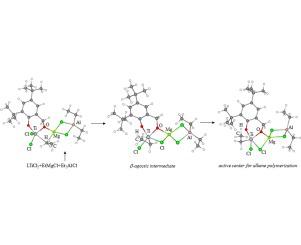Journal of Molecular Catalysis A: Chemical Pub Date : 2016-09-19 , DOI: 10.1016/j.molcata.2016.09.027 Leila Y. Ustynyuk

|
DFT modeling of the active centers formation in the catalytic system LTiCl2-Bu2Mg-Et2AlCl for alkene polymerization, where L is a bidentate ligand of saligenin type, suggests the three-step mechanism of this process. This mechanism includes the addition of the most probable alkylating agent, RMg(μ-Cl)2AlR2 or RMg(μ-Cl)2MgR (R = alkyl), to LTiCl2 with the formation of the trinuclear heterocomplex with the alkyl bridge bond Mg–C–Ti, followed by its two-step isomerization into the active center via the β-agostic intermediate. The free energy changes at the stages of the addition and isomerization are negative; the maximal energy barrier on the reaction pathway is small. In the Mg-free system LTiCl2-AlR3, the isomerization proceeds through the single energy barrier with a significantly higher amplitude. This could be the reason for a relatively high activity of the Mg-containing system and inactivity of the Mg-free system.
中文翻译:

后二茂钛催化体系LTiCl的DFT建模2 -Bu 2的Mg-ET 2的AlCl用于烯烃聚合:烷基桥的Mg-C-Ti和β-agostic C-H-Ti键的活性中心的形成中的作用
在该催化体系LTiCl活性中心形成的DFT建模2 -Bu 2的Mg-ET 2的AlCl用于烯烃聚合,其中L是水杨醇型的双齿配体,表明该方法的三个步骤的机构。该机构包括在加入最可能的烷基化剂的,RMG(μ-Cl)的2为AlR 2或RMG(μ-Cl)的2 MGR(R =烷基),以LTiCl 2形成具有烷基桥键Mg–C–Ti的三核杂配合物,然后通过β-声波中间物将其两步异构化为活性中心。加成和异构化阶段的自由能变化为负;反应路径上的最大能垒很小。在不含Mg的系统LTiCl 2 -AlR 3中,异构化通过单个能垒以明显更高的幅度进行。这可能是含Mg系统相对较高的活性和无Mg系统不活跃的原因。











































 京公网安备 11010802027423号
京公网安备 11010802027423号